Looking for a new digital marketing agency that can accelerate your results? Schedule a free marketing evaluation with our team to meet the right agencies. It’s fast, free, and we get it right.

Studies show that marketers who set goals with a digital marketing plan are more likely to report success over those who don’t by a whopping 429%.
But you can’t just set some marketing goals and call it a day. You have to put in the time and effort to reach them.
You’ve probably heard the saying: “a goal without a plan is just a wish.” A digital marketing goal without a plan is simply that.
Just as a business without KPIs (key performance indicators) is navigating towards an unknown destination, rudderless and without a compass.
A marketing plan describes who your customers are, how they gather information, and how you plan to target them and win them over.
Your marketing plan should also outline which marketing channels you plan to use in the process.
But what’s the point of taking on all of the hard work that goes into creating a marketing plan in the first place?
Because you need a marketing plan to identify opportunities which will help you create your company’s marketing strategy.
Table of Contents
Why Are Marketing Strategies Important?
The overall goal of a marketing plan is to:
- Layout analysis of the current state of your company.
- Provide an overall summary of your marketing goals.
- Describe and define your target audience.
- Define any strategies you will use to meet your marketing goals
- Set a budget for your marketing campaign.
Marketing plans typically look something like this:
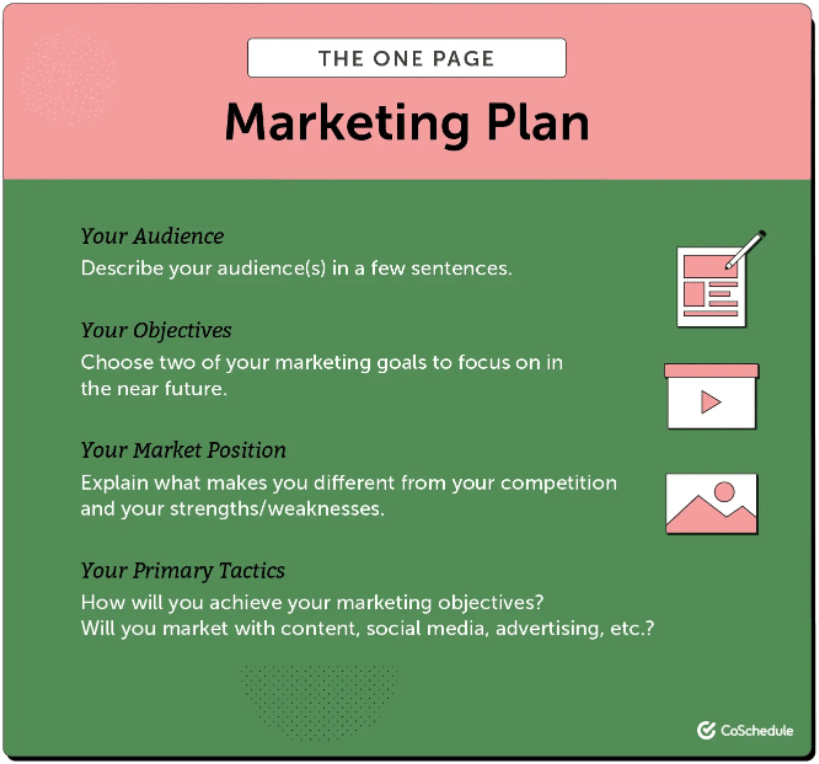
Not every marketing plan is the same. They vary depending on the type of industry or organization they’re for and the purpose they serve.
For example, a marketing plan might outline a general overview of a brand’s entire marketing game plan, or it might focus specifically on a social media marketing plan.
The type of company that you run can also determine the kind of marketing plan you use. A marketing plan for a nonprofit company, for example, will differ from a corporate marketing plan.
Marketing is extremely important for building up your brand’s name. Without it, potential customers won’t know that you or your products and services exist.
Eyes are the prize and without a marketing plan, you will get a whole lot less out of your content strategy and website.
If potential customers don’t know that you exist, they certainly won’t buy from you.
In 2021, total revenue generated from social media advertising crossed the 50 billion dollar threshold for the first time. Experts project that will jump to 75 billion dollars by 2025.

This is just one reason why you need to lay out a strategy for which digital marketing channels to use, who to market to, how you’re going to do it, and at what budget.
Your marketing plan outlines a marketing strategy in a document that can be clearly followed and referred back to.
That way, there’s no question about how your company plans to build brand awareness. This document is usually used for a pre-set period (e.g. quarterly, bi-annually, annually).
Your marketing plan should be ever-changing, laying out costs, goals, and steps to tackle marketing trends as they change.
The first step to building a successful marketing plan is to define your goals.
Define Your Business Goals
Start by defining clear business goals and business objectives.
This should lead to insights on how you can drive traffic and leads, generate more sales and awareness for your brand, and hone in on your target your audience.
These goals lay out exactly what you need to do to create an actionable plan that will bring in the results you need.
When coming up with goals, use the SMART method: Specific, Measurable, Attainable, Realistic, and Time-bound.
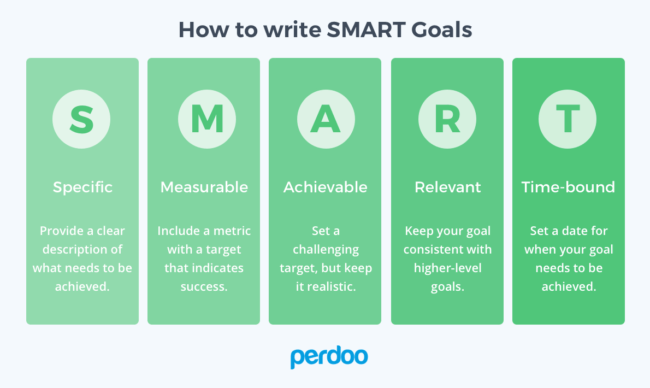
Examples of some SMART goals are:
- Increase revenue by X% within the next year
- Reach $X dollars in sales within the next six months
- Boost profitability by X% by the end of the quarter
SMART goals allow you to track data that helps deliver the results desired within the pre-determined period of time.
Once you know the goals of your marketing plan, you can begin to determine who your target personas are.
Figure Out Your Target Personas
As your company grows, one message or marketing approach won’t work for everyone.
That’s why you have to customize your approach by uncovering buyer personas and targeting each one differently.
These personas are fictional descriptions of your target customers based on their behavior, motivations, age, spending habits, concerns, demographic location, and more.

This is important because 71% of companies that exceed revenue/lead goals say they have documented buyer personas.

The first step to creating buyer personas is to create a list of who you want to target and why. Once you’ve done this, identify buyer personas that have similar needs and then merge similar personas together.
Then, prioritize each persona based on factors such as the size of the persona group or the likelihood of the group’s decision to purchase.
The next step is to determine your unique selling proposition, commonly referred to as your USP.
Determine Your Unique Selling Proposition (USP)
Your company’s USP is what makes your brand and the products or services you sell stand out from the crowd.
It should disclose what value your business or product provides that sets you apart from your competition.
Do you offer higher quality products than others? Better prices? More sophisticated, user-friendly software?
If you don’t sell customers on your USP, you’ll have a difficult time winning them over against the competition.
A real-life example of a USP in action is pizza chain Papa John’s popular tagline: “Better ingredients. Better pizza.”
To come up with your own, try and create a tagline by combining what your brand does well along with what the consumer wants.
Think about pain points you solve for your customers. This is the story that matters to them – and that’s the story that matters most to your business.
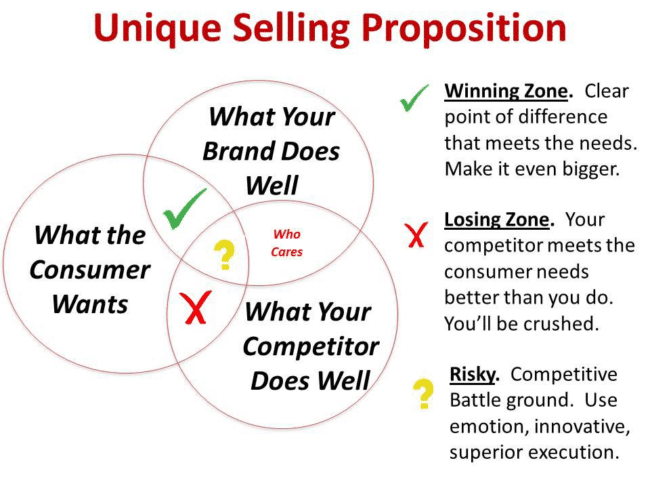
The next step to building your marketing plan is to decide on a budget.
Develop a Budget For Your Marketing Efforts
Set aside a certain percentage of your company’s projected gross sales to use toward your annual marketing budget.
Determine your budget by comparing what the marketing tactics needed to reach your buyer personas will cost against your available budget.
You should be able to fit this in even the tiniest of budgets.
A good rule of thumb for new companies is to set aside 12 to 20% of gross revenue for marketing campaigns.
Established companies should set a budget of 6 to 12% of gross revenue for marketing campaigns.
Remember that social platforms, like Facebook and Instagram, operate on a pay-to-play model for brands.
The average reach of an organic post on a Facebook Page in 2021 was about 5.20%.
That means roughly one in every 19 fans sees the page’s non-promoted content. Even if you put out fantastic content, only a minuscule amount of your audience likely sees that content.
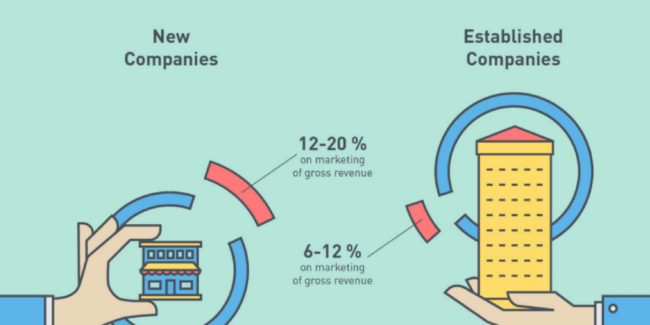
If you find that the costs of the marketing tactics you plan to tackle exceed your budget, adjust your tactics to fit within the parameters of what you can afford for now.
The boost in revenue gained from your marketing initiatives may be enough to increase the budget when crafting your next marketing plan.
Be cautious against wasting portions of your marketing budget on unnecessary costs, too.
Once you’ve set your budget, create a pricing strategy that will best help you achieve your marketing goals.
Create A Pricing Strategy
When you set prices, you should choose them with your marketing strategies and budget in mind.
The overall goal is to generate a profit. To define your pricing strategy, base prices on costs by calculating costs and simply adding your desired profit per unit sold.
You can also base it on the competition by deciding to charge a similar price as they are, or you can use the penetration strategy by setting a low price to acquire market share fast.
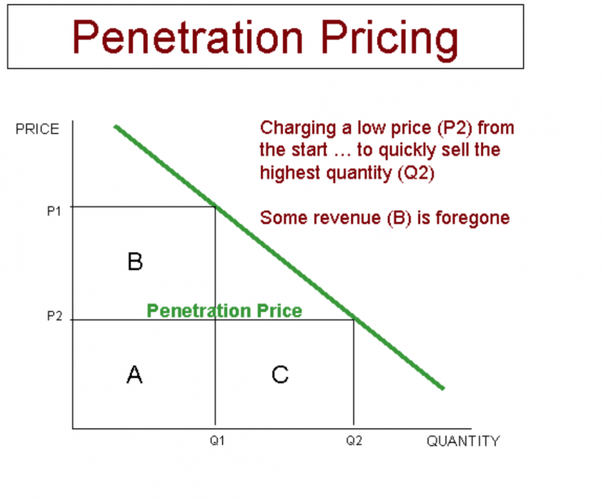
If you’re offering several products or services, you should also consider bundling them to give buyers a bigger bang for their buck.
Next, you’re ready to start writing your marketing strategy.
Write Your Own Marketing Strategy
Your marketing strategy should serve as a reference guide that you can share with team members and shareholders alike.
By sharing the document, you’ll be able to receive transparent, valuable feedback.
Don’t be afraid to alter it at any point if your marketing goals or budget change.
According to HubSpot, every marketing strategy should be structured as follows:
- Business Summary: this can include your company name, marketing team, headquarter/office locations, company mission statement, and SWOT analysis
- Business Initiatives: include information like company initiatives and marketing goals/metrics in this section
- Target Market: disclose your industry name, buyer personas, and a competitive analysis
- Market Strategy: information about your product, prices, promotion, etc. can be explained here
- Budget: list the amount of the projected marketing budget
- Marketing Channels: disclose which marketing channels you plan to use to achieve your goals
If you’re looking for some marketing plan examples, keep reading.
Two Marketing Plan Template Examples
Keep things simple and minimal, like Uber.
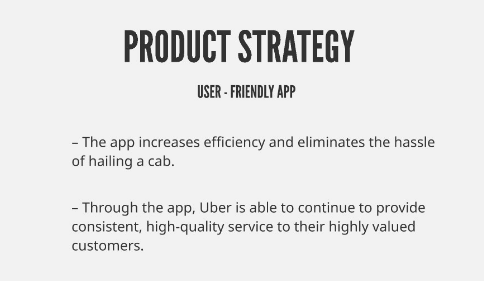
Uber’s marketing plan is centered around the “four P’s of marketing,” which are:
- Product
- Price
- Place (also known as distribution)
- Promotion
In their marketing plan, Uber also presents their budget and monthly plan of action.
The minimalistic layout is in line with Uber’s simple branding design, making it easy to read, understand, and use.
If you want to make things even more straightforward, try to limit your entire marketing plan to one page, like this one-page marketing plan example for Starbucks:
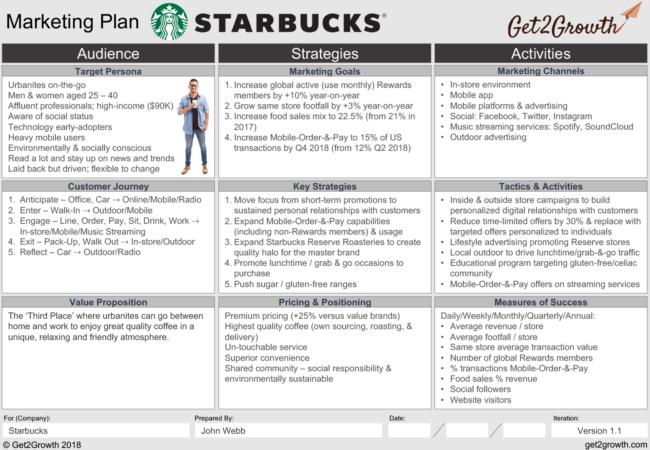
According to this one-page plan, designed by the Content Marketing Institute, you should include:
- Information about your audience: List your target persona(s), customer journey, and value proposition
- Your strategies: Define your marketing goals, key company strategies to meet those goals, and your pricing and positioning plans
- Details about activities: List the marketing channels you plan to use, tactics and activities that support your marketing goals, and the measures of success you will use to track the effectiveness of your plan
Once you choose one of the marketing plan templates, fully build out your marketing plan, and you and your team have begun to tackle it, you can start tracking your results and measure the success of your plan.
Track Your Results
Your marketing plan will not bear fruit if you don’t keep track of your results.
By doing so, you’ll be able to take your marketing plan from a formal document to a living, breathing piece of measurable data that can change as your business changes.
The way you go about tracking each component of your plan will depend on the specific marketing strategies that you chose to use.
For example, you can easily track online marketing efforts by using analytics software like Google Analytics/Google Data Studio to monitor paid online channels.
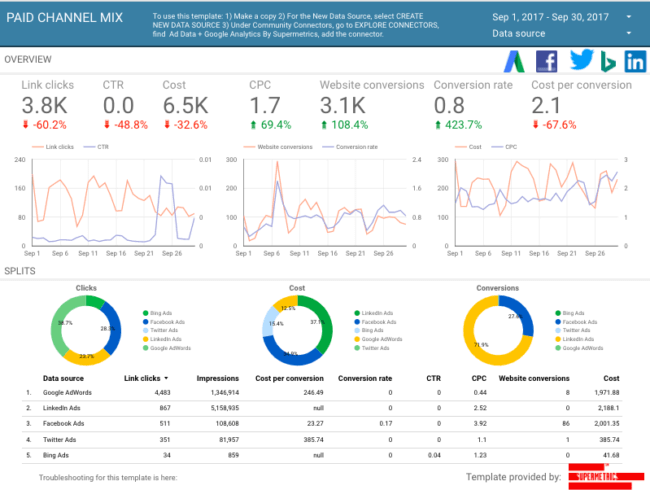
You can track other online efforts, like social media, by recording metrics like engagement or your follower count with a tool like Klipfolio:
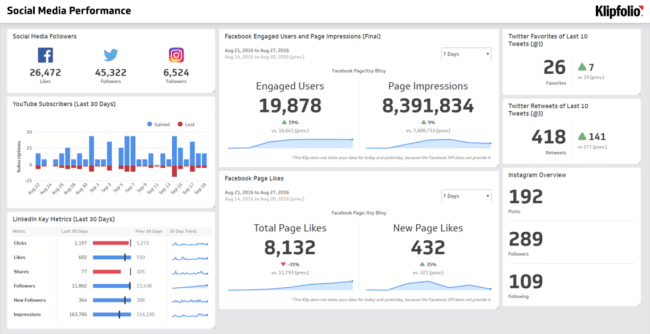
Any offline methods that you chose to use will need to be tracked manually.
The more accurate you can track your results, the better you will be able to adjust your marketing plan in the future.
For example: Not seeing the payoff you want in a certain area or with a certain buyer persona? Try to identify what the data you’ve collected might say about how to fix that.
Again, this is where measurable data such as KPIs and OKRs are invaluable to your business.
Conclusion
Marketers who set goals are more successful than those who don’t. But setting a goal isn’t everything. You also have to develop a plan to meet that goal.
Your marketing plan should be ever-changing, just like your business.
To get started building a successful marketing plan, you and your team should first define your goals.
Use this checklist to get started:
- Come up with SMART goals, which are Specific, Measurable, Attainable, Realistic, and Time-bound.
- Then, determine your target personas. Prioritize them based on their size or purchasing impact.
- Determine your unique selling proposition, or USP, so that you can stand out from competitors.
- This should be a simple tagline or phrase that tells prospective buyers who your brand is and why they should buy from you.
- Develop your budget. If you’re a new company, this should be 12 to 20% of your gross revenue. Established companies should plan to spend around six to 12% of overall gross revenue.
- Create a pricing strategy that works best for your brand’s bottom line. Use the penetration strategy to gain market share quickly.
- Once you’ve taken these steps, you’re ready to create a marketing plan. Keep the design minimal, short, and easy to digest to stand out.
- Track your results so that you can accurately adjust your marketing plan in the future.
For additional guidance on building your marketing plan, try our Porter Service.

